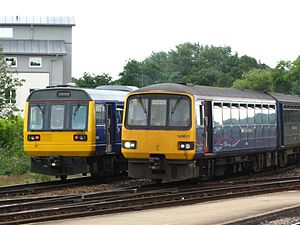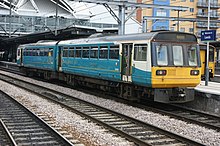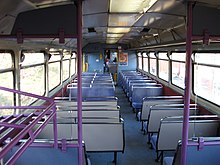Pacer
| Pacer | |
|---|---|
 | |
| In service | 1984– 2021 (production units) |
| Family name | Pacer |
| Constructed | 1980–1987 |
| Scrapped | 2020-2022 |
| Number built | 165 sets |
| Number in service | 15 sets (National Rail) |
| Number scrapped | 37 sets (142/143/144) |
| Operator(s) | Great Western Railway
Transport for Wales Regional Railways Arriva Trains Northern Arriva Trains Wales Arriva Rail North Northern Rail Northern Trains Valley Lines Wales & Borders Wessex Trains Islamic Republic of Iran Railways (1997–2005) |
| Specifications | |
| Maximum speed | 75 MPH |
| Track gauge | 4 ft 8 1⁄2 in (1,435 mm) standard gauge |
Pacer trains were railbuses built by British Rail between 1980 and 1987. There were several classes of them: 140, 141, 142, 143 and 144. They were diesel multiple unit trains, meaning each carriage had its own diesel engine. Pacers were built as a stopgap because British Rail did not have enough normal trains at the time and could not get new ones quickly enough. They were not supposed to be used for more than 20 years, but it actually took nearly 35 years to replace them.
Most Pacer trains were put out of use in 2020. Two things finally made this happen. The first is that it is difficult for people with disabilities to climb onto Pacer trains. The Rail Vehicle Accessibility Regulations require that all public passenger trains must be made easy to use for disabled people by 2020 - but they made an exception for the Pacer trains until the end of 2020. Only one Pacer (the modernised 144e) follows this rule right now. The second is that the Transport Secretary made a decision in 2015 to retire the Pacers by 2020 for the then-new Northern service, arguing that it would be bad for the economy in the north to keep using "these uncomfortable and low-quality vehicles".[1]
At the start of 2020, 138 Pacer units were still being used or stored by three National Rail operators: Northern Trains, Great Western Railway and Transport for Wales.[2] Northern Trains retired its last Pacer unit on 27 November 2020,[3] and so did Great Western Railway in December 2020. Transport for Wales kept using their Class 143s into the first part of 2021 until May 2021.
Features[change | change source]

The Pacer series were made to keep building and running costs low, so all of the Pacer units use:[4][5]
- A lightweight modified bus body and other things from buses, such as the seats. The driver's cab area is reinforced to make it safer in case of a crash.
- An underframe with just four wheels for the entire unit, instead of the usual two four-wheeled bogies (making eight wheels) that you would expect on trains. Passengers complained that this made for a noisy and bumpy ride. It also causes more wear to the wheels and track on tight curves.
Background[change | change source]
At the beginning of the 1980s British Rail (BR) needed to make new trains to replace its old first generation diesel multiple units (DMUs) which had been built between the mid-1950s and early-1960s. These old trains had helped replace steam and were popular with the public at the time. But BR did not get much money from the government, so could not get new trains that were just as good as the old ones. BR created two kinds of new second generation trains: the Sprinter series, for use on city and longer-distance services, and the Pacer series as cheap DMUs built using bus parts for short-distance countryside and branch line services.[6][7] The Pacers were intended as a cheap stopgap solution to the shortage of trains, and were not supposed to be used for more than 20 years.[4] BR set a challenge to several companies to design a cheap, lightweight train similar to railbuses. Since then, 165 Pacer trains (with 340 carriages in total) have been built. By 2015, some of these were over 30 years old.
They also tried to sell Pacers by showing them in the USA, Northern Ireland, Belgium, Sweden, Thailand, Malaysia and Indonesia, but no one bought any there. However, Iran bought leftover Class 141 units, for use on suburban lines around Tehran until 2005.[6]
Class 140[change | change source]

The Pacer series was the outcome of an idea to try using bus parts to create a diesel multiple unit. The first prototype, known as LEV 1, was made by British Rail Research Division and Leyland Motors working together. It used a bus body that was mounted on a modified freight train underframe (HSFV1). In 1980 they also built a two-car prototype class 140 at British Rail Engineering Limited (BREL)'s Derby Litchurch Lane Works.
Class 141[change | change source]

Then they built 20 more two-car units, forming the Class 141 fleet that was used mostly for suburban services in Yorkshire. They could carry 94 passengers in each set of two cars. Their two Leyland TL11 engines gave a total of 410 bhp (310 kW), making for a top speed of 75 miles per hour (121 km/h).
The 141s were built with Leyland National bus bodies that were so narrow that they could only be fitted with standard bus seats. The later Pacers had widened body panels to allow better seating.
The entire class got a technical upgrade in 1988 at the Hunslet-Barclay works in Kilmarnock.
The units were withdrawn from British Rail in 1997. Many were sold to Islamic Republic of Iran Railways[8] but have been withdrawn and are left in disused sidings in Iran.[9] A few are preserved at museum sites.
Class 142[change | change source]

The next and largest Pacer class was the Class 142. This again was built by Leyland and BREL, in 1985. The body was based on a Leyland National bus, built at Workington in Cumbria. Many fixtures and fittings of the Leyland National could be found on the units. The new class could carry more passengers: 120 passengers per two-car set. The same engines were used.
The first sets were used on Devon and Cornwall branch lines and on commuter services in the north west. The units from Cornwall were eventually moved to Liverpool and the north east, so the Class 142s were often seen on services across the north of England.
In the early 1990s, the 142s got more powerful Cummins engines, which gave a total power output of 460 bhp (340 kW) per two-car set. Several units were then changed for use on the Merseyside PTE City Line on Merseyrail in the Liverpool region, giving them dot-matrix route signs, better seating and Merseyrail PTE paintwork.
When privatisation happened, the class 142s were taken over by Arriva Trains Northern and First North Western, and then by Northern Rail, Arriva Rail North, Northern Trains, Arriva Trains Wales and Transport for Wales. Eight Northern Rail units were withdrawn from service for a while and replaced by a series of British Rail Class 158s.[10] First Great Western received 12 units on loan from Northern Rail from December 2007 to November 2011 (five units were returned to Northern in December 2008). This allowed most of its Class 158 fleet to be rebuilt as three-car sets.
Class 143 and Class 144[change | change source]

Around the same time that the Class 142 was developed, another class of Pacer railbus was designed by Kilmarnock-based Hunslet-Barclay. These used a Walter Alexander bus body. They were given the number Class 143 and started being used in 1985. Its two 205 bhp engines gave a total output of 410 bhp (310 kW) and a top speed of 75 mph (121 km/h). This class of Pacer originally had a capacity of 122 passengers. They were used in the North East before being transferred to Wales and the South West, and were moved over to Valley Lines and Wales & West control during privatisation. They then passed on to Arriva Trains Wales, Wessex Trains, First Great Western and Transport for Wales. The interiors were completely changed in 2000, when the Valley Lines service was introduced, with full back, coach-type seating installed throughout, along with improved fittings. This reduced seating capacity to 106 seats per set.
Then came a similar Class 144 unit, a Walter Alexander body on BREL underframe, which was introduced in 1987. A unit was formed of either a two-car set with 122 seats or a three-car set with a total capacity of 195 passengers and 690 bhp (510 kW), but its top speed was still 75 mph (121 km/h). The units were used in the North East, passing to Northern Spirit at privatisation, then to Arriva Trains Northern, Northern Rail, Arriva Rail North and now Northern Trains.
Advantages and disadvantages[change | change source]
Disadvantages[change | change source]
It has often been said that the Pacers are of poor quality. Instead of the usual bogies, Pacers use a basic four-wheel two-axle underframe. This often makes for a ride that is noisier and less comfortable than other trains, especially over points, and a loud squealing noise is heard around tight curves. Not having bogies also makes for a worse suspension and a bumpier ride; Pacers have been nicknamed "nodding donkeys" because of the trains' up-and-down motion on uneven track. The basic bench seating can also be uncomfortable.[4] The early units, especially the Class 141 s, were also very unreliable.[6]
Pacers have only been used in certain areas of the north and south west of England and the south of Wales, but not in the richer London or south east England areas. This has also created bad feelings.[4][6]
Safety worries were raised after the 1999 Winsford crash.[11] A Virgin Trains Class 87 express train ran into an empty First North Western Class 142 Pacer, after the Pacer had fouled the main line at Winsford, Cheshire on the West Coast Main Line.[12] The wire straps that held the body of the Pacer to its frame broke, separating the body from the frame and causing severe damage. The unit was written off. Twenty-seven passengers and crew were wounded, four badly. But all passenger injuries were on the other train, as the Class 142 was running empty at the time.[13]
Advantages[change | change source]
On the other hand, the Pacers were seen as a practical solution at a time when there was not a lot of money. They probably saved services on some rural lines that might not have been serviced by any trains at all if only more expensive trains had been available.[4] They have also proved cheap to run, achieving a fuel economy of 10 miles to the gallon.[6]
Replacements[change | change source]
As of 2020, the oldest Pacers on the national network were nearly 35 years old. All were planned to be withdrawn and scrapped by December 2019 as they do not comply with Rail Vehicle Accessibility Regulations.
CAF Civity[change | change source]
In July 2019, rollout of Northern's Class 195 CAF Civity units had begun on some routes. Because of this, refurbished Sprinters that no longer needed on those routes can be used to replace Pacers instead.
Vivarail D-Train[change | change source]
These units are built out of upcycled London Underground D78 Stock, built between 1978 and 1981, which were in service on the District line until 2017. To convert the old stock for mainline railway use, it will be necessary to re-use the aluminium bodyshells, traction motors and bogies from the D78 units and fit them out with new diesel engines and interiors. The D-Train units underwent acceptance testing in 2015 and Vivarail pitched them to train operating companies (TOCs), especially those bidding for the Northern franchise.[14] While no orders were received from Northern, Transport for Wales will replace its Pacers with a combination of five D-Trains and trains taken over from other train operators,[15] and other TOCs have ordered D-trains to replace other outdated trains: South Western Railway for the Isle of Wight's Island Line,[16] and West Midlands Trains for the Marston Vale line[17]
"144e Evolution"[change | change source]
Porterbrook, which owns the Class 143 and Class 144 fleets, refurbished 144012 in 2014 to comply with the new legislation, dubbed the "144e Evolution" unit. However, no other units have been refurbished to this standard. [18][19]
Preservation[change | change source]
Several Pacers have been preserved for further use on heritage railways. The National Railway Museum has preserved 142001. [20]
In May 2019, the government asked the public how to re-use the trains after withdrawal from service. One of the suggestions was re-using them as public spaces, such as village halls or cafes.[21]
References[change | change source]
- ↑ "New trains to replace north of England's ageing rolling stock by 2020". The Guardian. 27 February 2015.
- ↑ "Pacers to continue into 2020, operators confirm". Railway Gazette. 22 October 2019. Retrieved 24 November 2019.
- ↑ Slater, Chris (27 November 2020). "Final call for hated pacer trains as last 'truck on tracks' makes final journey". Manchester Evening News. Retrieved 28 November 2020.
- ↑ 4.0 4.1 4.2 4.3 4.4 Kelly, Jon (7 March 2016). "Pacers: The train that the UK has struggled to get rid of". BBC News Magazine. Retrieved 5 June 2018.
- ↑ Rail Projects : The BRE-Leyland Pacers – the dream becomes a nightmare – www.aronline.co.uk
- ↑ 6.0 6.1 6.2 6.3 6.4 Simon Bradley (17 October 2015). "Will Pacer trains trundle into history at last?". Yorkshire Post. Archived from the original on 15 December 2017. Retrieved 19 October 2015.
- ↑ St John Thomas, David; Whitehouse, Patrick (1990). BR in the Eighties. Newton Abbot: David & Charles. ISBN 0-7153-9854-7.
- ↑ "Iranian Railways Rolling Stock". Archived from the original on 28 September 2011.
- ↑ http://share.bahnforum.info/transfer/e825dbc060ecc7caa98ce2687fe5a58c9db17011/Iran_2013/IMG_2301_1.JPG
- ↑ "Angel Trains leases 30 Class 158 diesel multiple units to Northern Rail" (PDF). Northern Rail. 13 March 2007.[permanent dead link]
- ↑ "Safety fears over commuter trains". BBC News. 2 July 1999.
- ↑ "Train driver averts disaster". BBC News. 23 June 1999.
- ↑ "Report by the Health and Safety Executive's Railway Inspectorate into the train accident at Winsford South Junction on 23 June 1999" (PDF). Health and Safety Executive. 1999.
- ↑ Browne, Stefanie (15 January 2015). "Vivarail ready to start converting first LU D-Stock". railmagazine.com. Bauer Consumer Media. Retrieved 24 January 2015.
- ↑ "£800m fleet renewal plan for new Welsh franchise". International Railway Journal, 4 June 2018
- ↑ "Class 484 - Trains for the Isle of Wight". VIVARAIL. Archived from the original on 9 December 2020.
- ↑ "First Class 230 begins passenger services between Bletchley and Bedford". London Northwestern Railway.
- ↑ "Brochure: Class 1143 & 144 Diesel Multiple Units" (PDF). Porterbrook. Archived from the original (PDF) on 11 March 2014. Retrieved 1 August 2015.
- ↑ Clinnick, Richard (1 May 2013). "Angel Trains to withdraw all its Class 142 Pacers by 2020". Rail. 721: 11.
- ↑ Pioneer Class 142 claimed for National Collection Rail Express issue 268 September 2018 page 76
- ↑ "Pacer trains 'could be used as village halls'". BBC News. Retrieved 13 June 2019.


